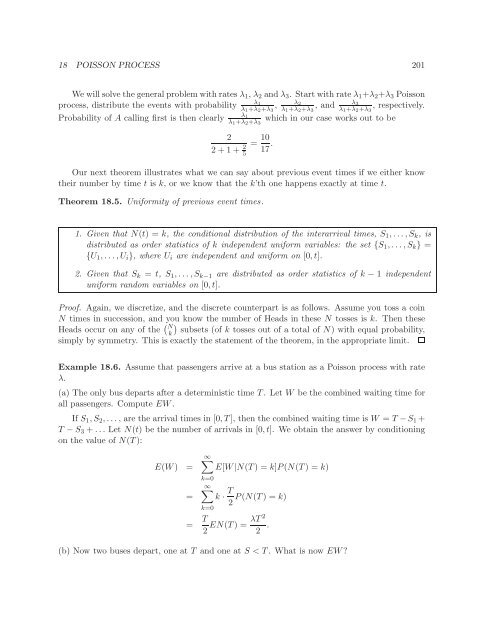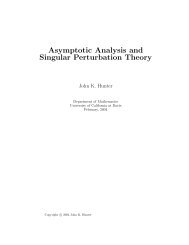18 Poisson Process
18 Poisson Process
18 Poisson Process
You also want an ePaper? Increase the reach of your titles
YUMPU automatically turns print PDFs into web optimized ePapers that Google loves.
<strong>18</strong> POISSON PROCESS 201<br />
We will solve the general problem with rates λ 1 , λ 2 and λ 3 . Start with rate λ 1 +λ 2 +λ 3 <strong>Poisson</strong><br />
λ<br />
process, distribute the events with probability 1 λ<br />
λ 1 +λ 2 +λ 3<br />
, 2<br />
λ<br />
λ 1 +λ 2 +λ 3<br />
, and 3<br />
λ 1 +λ 2 +λ 3<br />
, respectively.<br />
λ<br />
Probability of A calling first is then clearly 1<br />
λ 1 +λ 2 +λ 3<br />
which in our case works out to be<br />
2<br />
2 + 1 + 2 5<br />
= 10<br />
17 .<br />
Our next theorem illustrates what we can say about previous event times if we either know<br />
their number by time t is k, or we know that the k’th one happens exactly at time t.<br />
Theorem <strong>18</strong>.5. Uniformity of previous event times.<br />
1. Given that N(t) = k, the conditional distribution of the interarrival times, S 1 ,...,S k , is<br />
distributed as order statistics of k independent uniform variables: the set {S 1 ,... ,S k } =<br />
{U 1 ,... ,U i }, where U i are independent and uniform on [0,t].<br />
2. Given that S k = t, S 1 ,... ,S k−1 are distributed as order statistics of k − 1 independent<br />
uniform random variables on [0,t].<br />
Proof. Again, we discretize, and the discrete counterpart is as follows. Assume you toss a coin<br />
N times in succession, and you know the number of Heads in these N tosses is k. Then these<br />
Heads occur on any of the ( N<br />
k)<br />
subsets (of k tosses out of a total of N) with equal probability,<br />
simply by symmetry. This is exactly the statement of the theorem, in the appropriate limit.<br />
Example <strong>18</strong>.6. Assume that passengers arrive at a bus station as a <strong>Poisson</strong> process with rate<br />
λ.<br />
(a) The only bus departs after a deterministic time T. Let W be the combined waiting time for<br />
all passengers. Compute EW.<br />
If S 1 ,S 2 ,... , are the arrival times in [0,T], then the combined waiting time is W = T −S 1 +<br />
T − S 3 + ... Let N(t) be the number of arrivals in [0,t]. We obtain the answer by conditioning<br />
on the value of N(T):<br />
E(W) =<br />
=<br />
∞∑<br />
E[W |N(T) = k]P(N(T) = k)<br />
k=0<br />
∞∑<br />
k=0<br />
k · T P(N(T) = k)<br />
2<br />
= T λT<br />
2<br />
EN(T) =<br />
2 2 .<br />
(b) Now two buses depart, one at T and one at S < T. What is now EW?
















